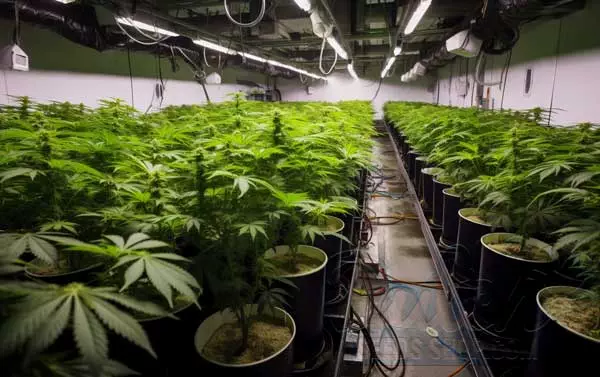How to Grow Lemon Haze Strain
If you’re searching for a strain that brings on the citrusy vibes with a splash of euphoria, Lemon Haze is your go-to green. Lemon Haze offers the perfect balance of uplifting energy and potent relaxation. But how do you grow this beauty? Let’s roll up our sleeves and get to the nitty-gritty.

Get To Know Lemon Haze Strain
From its intriguing parent strains, Lemon Skunk and Silver Haze, Lemon Haze inherited its distinctive aroma and hard-hitting effects.
With a THC content ranging from 17% to 24% and CBD levels under 0.4%, this strain promises a euphoric high without much of a CBD cushion.
Often reviewed as a top choice for daytime activities, Lemon Haze has won its fair share of cannabis awards.
Pictures and videos of its radiant green buds can make any enthusiast salivate.
In a nutshell, if you want a popular strain that’s relatively easy to grow and offers a balanced, uplifting high, look no further.
Tips and Tricks for Growing Lemon Haze Successfully
To turn that tiny Lemon Haze seeds or clones into a towering tree of green, you’ll need to nail a few essential details.
First, get acquainted with its growth stages.
This is a Sativa-dominant strain, 70% Sativa and 30% Indica, so expect a tall plant.
The flowering time usually ranges from 56 to 63 days, and the growing difficulty is generally considered easy.
Here’s a quick rundown of tips:
- Select top-notch seeds or clones: Make sure your initial plant material is high quality.
- Gather Your Tools: Have your accessories and cultivation tools ready before you start.
- Watch the Climate: Lemon Haze loves a warm climate.
- Be Mindful of Space: Given its height, ensure you have adequate space for growth.
Lemon Haze Indoor Growing
Alright, folks, let’s take a deep dive into the indoor cultivation of Lemon Haze.
Growing this strain indoors can be like assembling the ultimate playlist; every detail, from lighting to climate, adds a unique note.
So, let’s jam!
Benefits of Indoor Growing
Indoor cultivation of Lemon Haze offers a level of control that can make even the most seasoned growers swoon.
With indoor growing, you become the architect of your plant’s destiny.
Want to shoot for optimal THC levels? No problem, you can micromanage light cycles and nutrient delivery.

Worried about those dreaded spider mites? You can curate the environment to be as inhospitable to pests as possible.
The ability to control humidity, temperature, and light cycles translates into bigger yields and potent buds, packed with that citrusy goodness.
Additionally, indoor growing allows for multiple harvest cycles, so you can keep the green rolling in all year long.
| Benefit | What It Means for Lemon Haze |
| Controlled Climate | Perfect temps for optimal growth |
| Pest Management | Lower risk of infestations |
| Multiple Harvests | More buds, more often |
| Privacy | No nosy neighbors |
Setting Up Your Indoor Grow Space
First thing’s first: your grow space is like the stage for your Lemon Haze rockstars.
Whether you’re utilizing a tent, a closet, or a dedicated room, this space should be clean, organized, and efficient.
Ventilation is a non-negotiable; proper air circulation helps keep the mold and pests away.
Also, invest in quality grow lights, as Lemon Haze loves to bask in bright but not too harsh light.
The growing medium should align with your skill and desired yield.
Essentially, every square inch should serve a purpose.
Prepping early makes life a ton easier.
- Ventilation system: Extractor fans, air input, carbon filter
- Lights: HID, LED, or Fluorescent
- Growing Medium: Soil, coco, hydroponics
- Containers: Fabric pots, plastic containers, hydroponic setups
Climate Control
Climate control in an indoor setting isn’t just setting and forgetting a thermostat; it’s an ongoing affair, especially for Lemon Haze.
This strain thrives at a temperature range of 70-80°F and humidity levels of 40-50% during the flowering stage.
Too much humidity, and you risk mold.
Too low, and your buds dry out.
Automated climate controllers can take out the guesswork, but don’t just rely on gadgets.
Manual monitoring is also critical, as machines can and do fail.
If you’re using HID lights, air-cooled reflector hoods are your new best friends.
They help manage heat levels, ensuring your Lemon Haze plants don’t get too hot or too cold.
Lastly, the airflow needs to be robust, meaning you should use an oscillating fan to maintain constant air movement.
Types of Lights
Ah, lighting – the soul food for your Lemon Haze.
HID lights are the old-school champs; they’ve been around for a while and do their job exceptionally well.

These lights are fantastic for both the vegetative and flowering stages.
Then there are LED lights, the new-age maestros.
They offer a full spectrum and are energy-efficient, making them great for light spectrum optimization.
Fluorescent lights are your budget-friendly options but are generally suitable only for small-scale or amateur grows.
| Light Type | Best For | Notes |
| HID | Both stages | High electricity consumption |
| LED | Both stages | Energy-efficient |
| Fluorescent | Small-scale grows | Less effective for flowering |
Growing Mediums and Containers
Let’s talk turf.
The growing medium for Lemon Haze can vary, depending on your skill level and what kind of results you’re chasing.
Soil is the traditional choice.
It’s forgiving and nutrient-rich but can be prone to pests and diseases.
Coco coir is a more inert medium, great for fast water absorption and offering more control over nutrients.
Then there’s hydroponics, the most advanced of the trio, allowing the plant’s roots to absorb nutrients directly from water.
As for containers, don’t overlook them.
Fabric containers allow excellent airflow and drainage.
Plastic containers are a cheaper option but ensure they have proper drainage holes.
Some also opt for air pots to maximize oxygen availability to the roots.
Caring for Indoor-Grown Lemon Haze
Taking care of your Lemon Haze indoors is like tuning a guitar; it needs regular adjustments.
Water quality is a big deal; always use clean pH-balanced water.
Over or under-watering can stress your plants, leading to decreased yield or, worse, diseases.
Nutrients should be introduced according to the plant’s growth stage.
During the vegetative phase, focus on nitrogen.
During the flowering stage, phosphorus and potassium are key.
Also, keep an eye out for any signs of nutrient deficiencies or excesses.
- Watering Schedule: Check soil moisture before watering
- Nutrients: Use balanced N-P-K fertilizers
- Pest Control: Neem oil, insect nets
- Pruning: Remove dead leaves and low branches
Odor Control
Indoor cultivation of Lemon Haze brings its challenges, and odor is one of them.
Sure, we love that citrusy aroma, but it can become overwhelming.
Plus, you don’t want the whole block knowing what you’re up to.
Carbon filters are a godsend in these situations.
Installed in your ventilation system, they can virtually eliminate odors.
Ozone generators are another robust but controversial option; while they effectively mask odors, they can be harmful if misused.
Odor neutralizers can also help, but be cautious as they can affect the taste of your buds.
The key is to control the smell without affecting the quality of your harvest.
Remember, maintaining a low profile is part of the game when it comes to indoor cultivation.
Lemon Haze Outdoor Growing
Going al fresco with Lemon Haze can be like that spontaneous jam session that just feels right.
The sun’s energy, the natural rhythm of the seasons, and a connection to Earth’s nutrients can help this strain reach its full potential.
So, let’s take the stage outside, shall we?
Benefits of Outdoor Growing
Ditching the controlled environment for the great outdoors can be a liberating experience for you and your Lemon Haze.
First off, natural sunlight is incomparable; it’s the ultimate light source that brings out the best in cannabis.

Plus, you get more growing space, meaning bigger plants and potentially larger yields.
Outdoor growing also saves on electricity costs, unlike indoor cultivation where lighting and climate control can spike your bills.
One other underrated benefit? Natural predators will help manage those nasty pests, reducing your need for synthetic pesticides.
| Benefit | What It Means for Lemon Haze |
| Natural Sunlight | Optimal light spectrum |
| Space | More room for root and canopy growth |
| Cost Efficiency | Less spending on electricity |
| Pest Management | Nature helps out |
Best Time to Plant Lemon Haze Outdoors
Timing is everything, just like dropping the bass at the right moment in a tune.
For Lemon Haze, the ideal planting time is late spring to early summer.
This timeframe allows your cannabis to fully enjoy the long summer days, soaking up all the light it needs for a bountiful harvest.
In colder climates, indoor seed germination before transitioning outdoors can give you a head start.
- Late Spring: Optimal starting point
- Early Summer: Last chance for healthy growth
- Pre-Germinate Indoors: If you’re in a colder climate
- Check Weather Forecasts: To avoid late frosts
Setting Up Outdoor Grow Spaces
Choosing your outdoor venue is like selecting the perfect setlist; it sets the mood for the entire grow.
Sunlight exposure is crucial – Lemon Haze craves at least 6 hours of direct sun per day.
Don’t forget about security; the grow area should be discreet and, if possible, enclosed to keep both human and animal intruders away.
Drainage is another essential element; standing water can spell doom for your roots.
Then there’s airflow; make sure your plants aren’t crowded to ensure good circulation.
- Location: Maximize sunlight exposure
- Security Measures: Fences, surveillance
- Drainage Systems: Raised beds, sloping ground
- Spacing: Adequate room between plants for airflow
Selecting and Preparing Soil

When it comes to outdoor cultivation, soil quality is the backstage tech crew that can make or break your show.
Lemon Haze thrives in well-drained, nutrient-rich soil with a pH level of 6 to 7.
Organic soil rich in microbial life can work wonders for nutrient absorption.
You can also amend the soil with organic composts like worm castings or bat guano to improve its structure and nutrient content.
Before planting, make sure to test the soil’s pH and nutrient levels.
Soil aeration is a must; compacted soil can impede root growth and limit water penetration.
Take the time to break up hard soil and mix in some perlite for better aeration.
Nutrients and Fertilizers
Nutrients and fertilizers are the roadies, making sure the main act – your Lemon Haze – shines.
In the vegetative stage, a higher ratio of nitrogen is vital, while during the flowering stage, phosphorus and potassium take center stage.
Make sure to use organic nutrients whenever possible, as synthetic ones can build up in the soil.
| Growth Stage | Primary Nutrient | Supplementary Nutrients |
| Vegetative | Nitrogen | Calcium, Magnesium |
| Flowering | Phosphorus, Potassium | Sulphur, Magnesium |
How to Maximize Lemon Haze Yield
To really knock it out of the park, you’ve got to understand your Lemon Haze inside and out.
For starters, training techniques like low-stress training or high-stress training can significantly boost your yield by exposing more bud sites to sunlight.
During the flowering stage, consider bud pruning to focus the plant’s energy where it counts.
Climate adaptability is also key; be prepared to protect your plants from sudden changes in weather.
Your goal is to create a superstar environment where your Lemon Haze can shine its brightest.
- Training Techniques: Low-Stress Training (LST), High-Stress Training (HST)
- Bud Pruning: Remove smaller buds to focus energy on larger ones
- Climate Protection: Greenhouse, cold frames
- Regular Monitoring: Keep an eye out for pests, nutrient deficiencies, and other issues
Growing Lemon Haze is a venture pulsing with rewards.
You’re not just cultivating a plant; you’re riding a wave of flavor, aroma, and therapeutic benefits.
Whether you go the indoor route, with its perks of climate control and privacy, or venture outdoors to harness the raw power of Mother Nature, Lemon Haze offers unique complexities and bountiful yields.
Mastering this strain is like nailing a tricky guitar solo; it requires attention to detail, a feel for rhythm – be it in light cycles or nutrient feeds – and a love for the art.
But once you get it down, oh man, the high notes you’ll hit in both yield and quality are worth every bead of sweat.
It’s a grow journey that challenges but promises a stash that’s a legit masterpiece.
So why is mastering Lemon Haze strain worth the effort? It’s simple.
The cannabis connoisseur in you will revel in the high-quality buds and the deep understanding of a strain that’s both classic and ever-evolving.
FAQ
What’s the flowering time for Lemon Haze?
Typically, Lemon Haze takes about 8 to 10 weeks to flower when grown indoors. Outdoors, you can expect to harvest around late September to early October, depending on your climate.
Can Lemon Haze be grown in a hydroponic setup?
Absolutely, Lemon Haze adapts well to hydroponic systems. Just remember to monitor nutrient levels closely, as hydro setups don’t have the natural buffers that soil provides.
How tall does Lemon Haze grow?
Indoors, Lemon Haze usually reaches a moderate height of around 3 to 4 feet. However, when given ample space outdoors, this strain can grow up to 6 feet tall or more.
Is Lemon Haze susceptible to any specific pests or diseases?
Lemon Haze is a relatively hardy strain but keep an eye out for spider mites and powdery mildew. Regular monitoring and preventive measures can keep these issues at bay.
What is the average yield for Lemon Haze?
For indoor setups, you can expect around 18 ounces per square meter. Outdoor yields can be more variable but tend to be more generous, often exceeding 25 ounces per plant with proper care.
About the Author
Share the Love:
